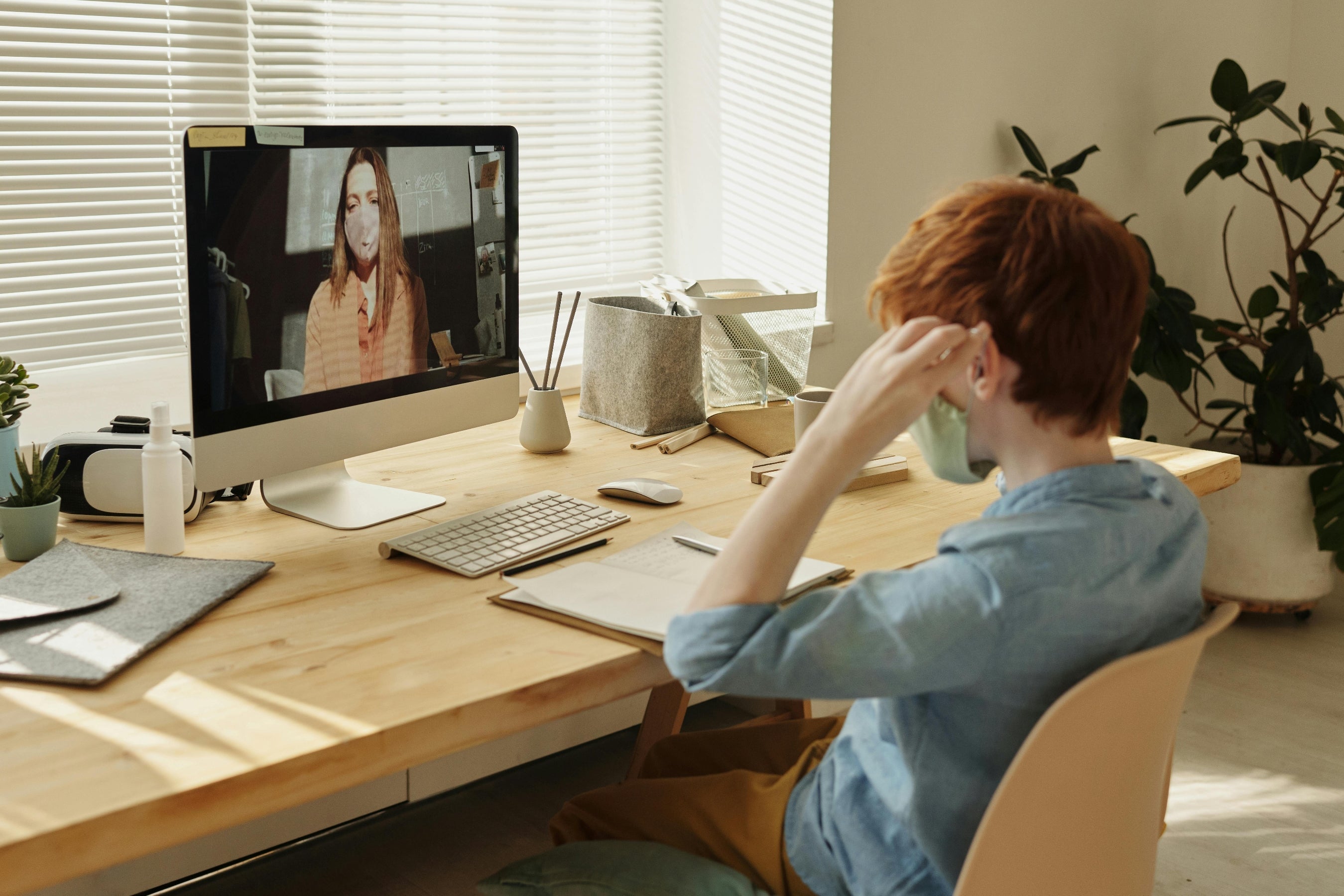Virtual talks are now normal in today's world of remote work. But a lot of people forget about a simple tip that can make their work experience a lot better: using a standing desk. There are real benefits to standing during video calls, such as better posture, fewer health risks, more mental focus, and more professional confidence. This guide will explain how a standing desk can change the way you do virtual meetings, making you more productive and making you feel better all day.
Physical Health Benefits of Using a Standing Desk During Virtual Meetings
Spine Alignment and Posture Correction
Standing desks naturally keep your neck in a neutral position, which stops you from slouching forward, which is bad for your health when you're sitting down. Long-term pressure on your neck and back muscles can be avoided by keeping your back straight and shoulders loose. This small change in posture can stop long-term joint problems that happen from sitting for long periods of time.

Combating Sedentary Health Risks
Sitting for long periods of time raises the chance of heart disease, diabetes, and obesity. This habit of being sedentary is broken by standing during meetings, which speeds up metabolism and burns more calories. Even 30-minute breaks of standing can greatly lower the health risks that come with being inactive for long periods of time.
Enhanced Blood Circulation
Blood flow is slowed down when you sit, especially in your legs and lower body. Standing desks improve blood flow, which lowers the risk of leg swelling, stiffness, and blood clots. Better blood flow is good for your heart health and can help avoid problems with the circulation system.
Lower Back Pain Reduction
Lower back pain can be eased by switching between sitting and standing. This active action keeps muscles from getting stiff, eases chronic pain, and is good for the health of your spine. By switching positions, you make the space around your body more stable for its structure.
Mental and Emotional Benefits of Using a Standing Desk During Virtual Meetings
Increased Meeting Alertness
During virtual meetings, standing automatically keeps your mind from getting tired. By staying standing, you stay more involved and focused, which stops your mind from wandering during meetings. Your brain stays sharp because of this physical activity, which helps you process information better and pay attention during conversations.
Stress Reduction and Mood Improvement
Moving while standing releases endorphins, which have a good effect on your mood right away. This natural change in biochemistry helps fight emotional exhaustion and worry at work. Just standing during meetings can change how you feel, giving you a quick mental restart and making you happier with your job overall.
Enhanced Professional Confidence
Your conversation style and how you see yourself are directly affected by how upright you are. Standing up straight naturally makes your body language better, which makes you look more sure of yourself and in charge when you're online. Taking this stance will make you feel more confident, which will help you interact better and give off a stronger professional vibe.
Cognitive Performance Boost
Standing puts your mind in a state of readiness that makes it easier to think and make decisions. Standing up sends signals to your brain to stay awake and responsive, which could help you think of new ways to solve problems and be creative in meetings.

Productivity Advantages of Using a Standing Desk During Virtual Meetings
Improved Communication Dynamics
Standing naturally enhances vocal performance by opening the diaphragm and improving breath control. This physical position allows for clearer, more powerful speech projection during virtual meetings. Your voice becomes more resonant and articulate, ensuring your messages are communicated with greater precision and impact.
Enhanced Nonverbal Communication
An upright position provides greater freedom of movement, enabling more natural and expressive gestures. This physical flexibility allows you to communicate more dynamically, using body language to emphasize points and maintain engagement during virtual discussions. Your communication becomes more nuanced and compelling.
Streamlined Work Transitions
Standing creates a more agile work environment, facilitating faster transitions between meetings and tasks. The physical readiness of a standing position reduces the mental and physical inertia typically associated with back-to-back virtual meetings. You can quickly shift focus, maintaining productivity and momentum throughout your workday.
Elevated Meeting Participation
A standing posture inherently signals professional attentiveness and readiness to engage. This physical stance encourages more active participation, making you more likely to contribute meaningfully to discussions. Your increased alertness and visible engagement can positively influence the overall meeting dynamics.
Challenges of Standing Desk Use During Virtual Meetings
Physical Discomfort and Fatigue
Prolonged standing can cause leg soreness, lower back pain, and overall muscle fatigue. Without proper preparation, users may experience significant physical strain during extended virtual meetings. The body needs time to adapt to new posture and extended standing periods.
Adaptation and Learning Curve
Transitioning from traditional seated work to a standing desk requires significant personal adjustment. Many professionals struggle with maintaining consistent standing habits, finding it uncomfortable or challenging to change long-established work routines. The initial discomfort can discourage continued use.
Limited Workspace and Financial Constraints
Not all home offices or work environments can easily accommodate standing desks. Space restrictions, high equipment costs, and limited budget pose significant barriers to implementation. Many standing desk solutions require substantial financial investment or significant workspace modifications.
Technical and Equipment Challenges
Ensuring proper ergonomic setup for virtual meetings while standing can be complex. Camera positioning, microphone placement, and maintaining a professional background become more challenging when transitioning between sitting and standing positions. Technical compatibility and equipment alignment require careful planning.

Strategies for Optimizing Standing Desk Performance During Virtual Meetings
Targeted Movement Routines
Develop a series of discrete, professional stretches and movements that can be performed during virtual meetings. Create a repertoire of subtle ankle rotations, leg shifts, and upper body stretches that maintain circulation without disrupting meeting dynamics. Focus on movements that can be executed seamlessly while remaining engaged in conversation.
Digital Tracking and Monitoring
Implement technology-driven tools to manage standing desk usage. Utilize smartphone apps and desktop applications that:
- Track standing duration
- Set personalized standing reminders
- Monitor posture and movement intervals
- Provide data-driven health insights
These digital solutions transform standing into a measurable, structured wellness practice.
Team Wellness Collaboration
Transform standing desk adoption into a collective organizational strategy. Develop team challenges, share individual experiences, and create a supportive environment that normalizes standing during virtual meetings. Establish a culture that views professional health as a shared organizational priority.
Personalized Adaptation Techniques
Design a customized standing approach that considers:
- Individual physical limitations
- Meeting frequency and duration
- Specific job role requirements
- Personal comfort and health conditions
Small, consistent adjustments can lead to significant improvements in workplace wellness. Success depends on patience, experimentation, and a commitment to personal health.
Transform Your Virtual Meetings Now!
Standing desks are more than just a trend in the workplace; they're a useful way to improve your health and work performance. Adding standing to your virtual meeting routine can help your health, your ability to think clearly, and your work. Start by making small, deliberate changes. For example, start with short periods of standing, try out different techniques, and pay attention to your body.




Share:
Top 5 Electric Standing Desks for Home Offices in 2025
How to Choose the Right Monitor Size for Your Workspace Setup